Trees Birds Mammals Fish Amphibians Reptiles
Wild Algarve
Bookshop
Sarcoscypha austriaca var. austriaca (O. Beck ex Sacc.) Boud. - Scarlet Elfcup
Phylum: Ascomycota - Class: Pezizomycetes - Order: Pezizales - Family: Sarcoscyphaceae
Distribution - Taxonomic History - Etymology - Identification - Culinary Notes - Reference Sources
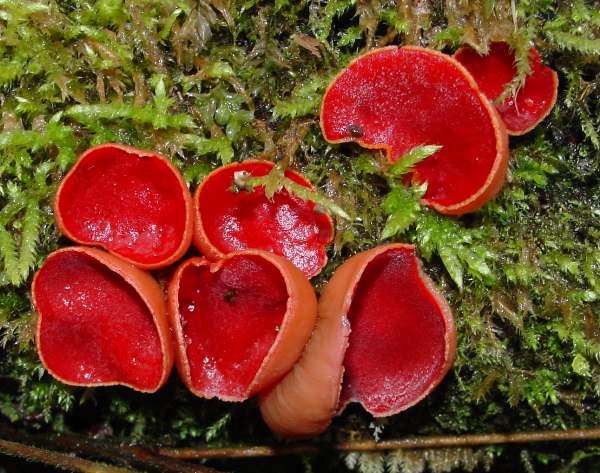
Sarcoscypha austriaca, commonly referred to as Scarlet Elfcup, (and the macroscopically almost identical Ruby Elfcup Sarcoscypha coccinea) appears in winter on dead twigs in damp, shady places, usually partly buried in moss.
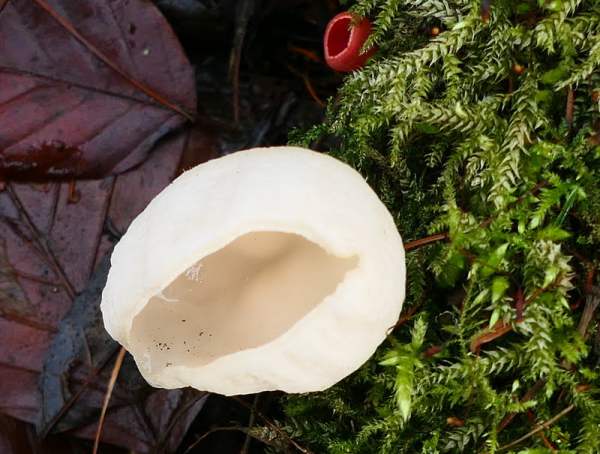
Above: The white form of Scarlet Elfcup, seen in Glenarm Forest, Northern Ireland
Nearly always bright (scarlet!) red, when you find a colony it is always worth searching for more nearby, as there is a chance of comming across an orange-yellow form (very rare in Britain and Ireland) or even the exceptionally rare white form shown above and below:
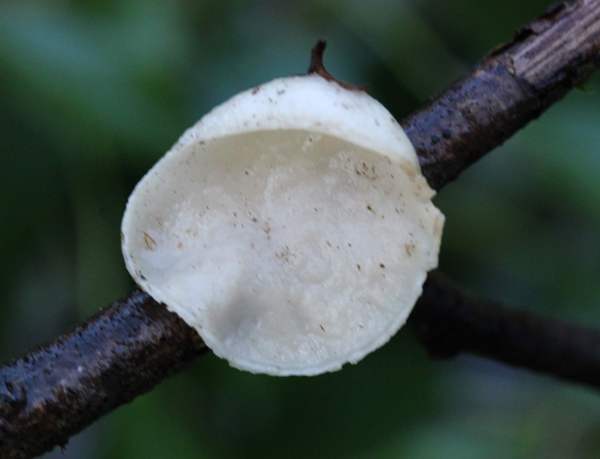
Above: Call me Scarlet! The very rare white form of Scarlet Elfcup.
In recent years Sarcoscypha austriaca has been the more frequently recorded of the two red elfcup species in Britain and Ireland, whereas in the past Sarcoscypha coccinea was most commonly recorded. Difficulties in identification may be a significant factor in this, of course.
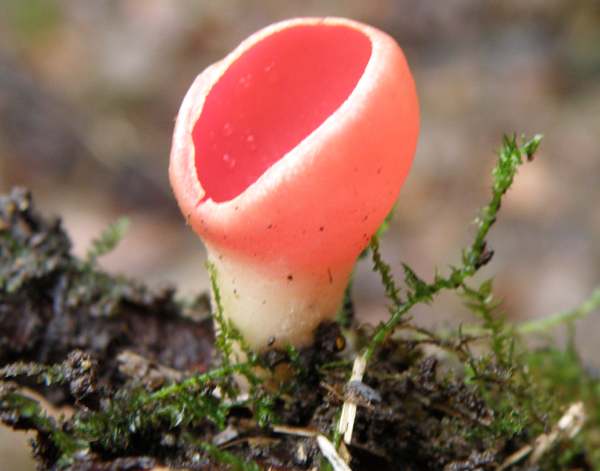 The following discussion appears also on our page for the Ruby Elfcup, Sarcoscypha coccinea.
The following discussion appears also on our page for the Ruby Elfcup, Sarcoscypha coccinea.
I have almost convinced myself that the Ruby Elfcup is usually a darker red than the Scarlet Elfcup, but as both species can vary considerably in colour from pale orange through to deep red it is simply not sensible to make colour part of the identification process. Ruby Elfcup fruitbodies rarely exceed 5cm across when fully expanded, whereas I have found Scarlet Elfcups more than 7cm across; however, the size overlap is such that again it is no real help in determining which of the two species you have found. A microscope is therefore the only way of being reasonably confident. Even then, it is much better to rely on measuring a set of features rather than gambling on a single observation. The spores of both of these species are elongated ellipsoids and, unfortunately, with a size overlap; however, some of the mature spores of Sarcoscypha austriaca produce conidial 'buds' which give their ends a hammerhead appearance, whereas the end of spores of Sarcoscypha coccinea are always rounded without budding protrusions.
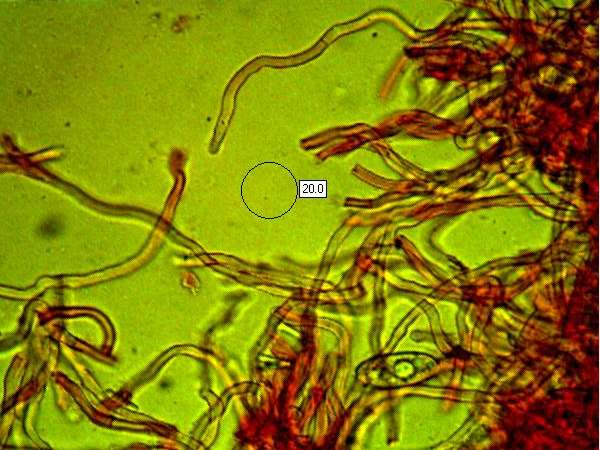
Above: Seen through a x400 microscope, the tiny hairs on the surface of a Ruby Elfcup Sarcoscypha coccinea are matted, but they are not coiled.
Another distinguishing feature is the hairy outer surface of the cups, which are covered in a matted felt (tomentum) of tiny uncoiled hairs in the case of Sarcoscypha coccinea and coiled (like a corkscrew) hairs in the case of Sarcoscypha austriaca.
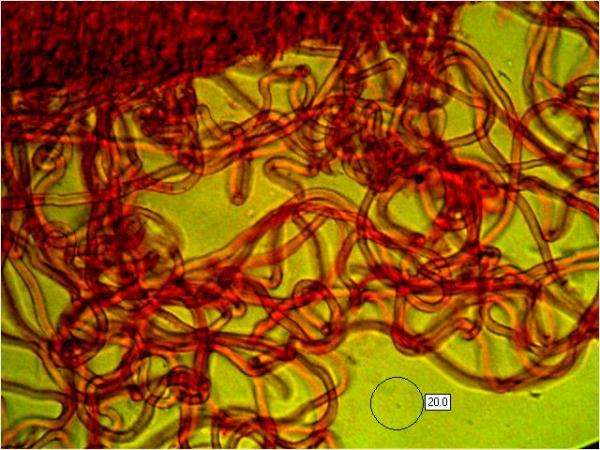
Above: with Sarcoscypha austriaca, the Scarlet Elfcup, the hairs (tomentum) on the outer (infertile) surface of the cups are coiled rather than being straightish as they are for the Ruby Elfcup.
Although distribution information for the two red elfcup species found in Britain goes back many decades, records prior to the turn of the present century may be seriously inaccurate as the distinction between various Sarcoscypha species (worldwide there are quite a few) was not clear until 1997, when American mycologist Francis A Hamilton et al. used molecular sequencing to infer the cladistic (evolutionary) relationships between the species within this difficult genus.
Some field guides refer to one or other of these two species having the longer stem, but in my experience the depth of moss through which they emerge from their buried timber substrate largely determines the stem length.
Another discriminating factor could be the substrate upon which these ascomycetes are feeding. Scarlet Elfcup is partial to a wide variety of hardood twigs including Sycamore, willows and Hazel. Ruby Elfcup is also a hardwood rotter, and it occurs on Beech and elms as well as Hazel. So both species can occur on Hazel... and rotten twigs are far from easy to identify to species level!
What all this says is that to be anywhere near certain which of the two red elfcup species you have found, microscopic study (unless you are equipped to carry out DNA analysis!) is probably the only option.
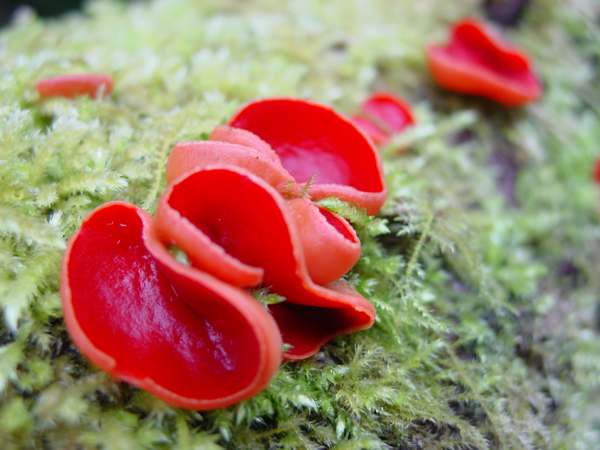
Distribution
Fairly frequent and widespread across Britain and Ireland, specially in areas of high rainfall, the Scarlet Elfcup occurs also in many parts of mainland Europe. This ascomycete fungus is also reported from parts of North America.
Taxonomic history
Described in 1884 by Austrian mycologist Günther Beck von Mannagetta und Lerchenau (1856 - 1931), when it was given the scientific name Peziza austriaca, this species was moved to the genus Sarcoscypha in 1907 by French mycologist Jean Louis Emile Boudier (1828 - 1920) and given its current scientific name Sarcoscypha austriaca.
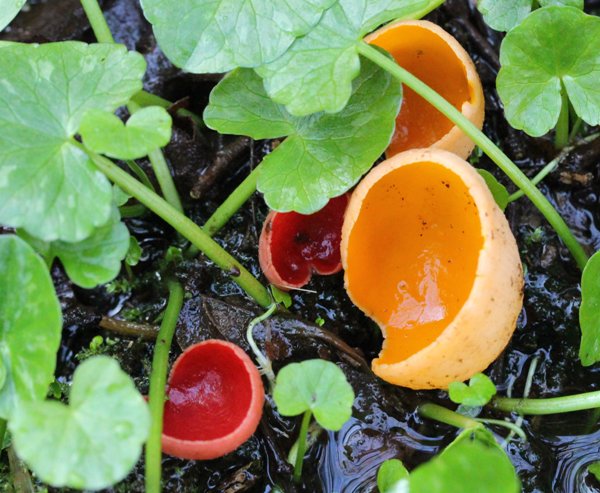
Above: The rare orange form of Sarcoscypha austriaca, here growing with the common red form, on wet rotting hazel twigs.
The nominate (red) form became Sarcoscypha austriaca var. austriaca when, in 1999, Sarcoscypha austriaca var. lutea (a yellow-orange form - see below) was described by Italian mycologists S. Ruini and E. Ruedl.
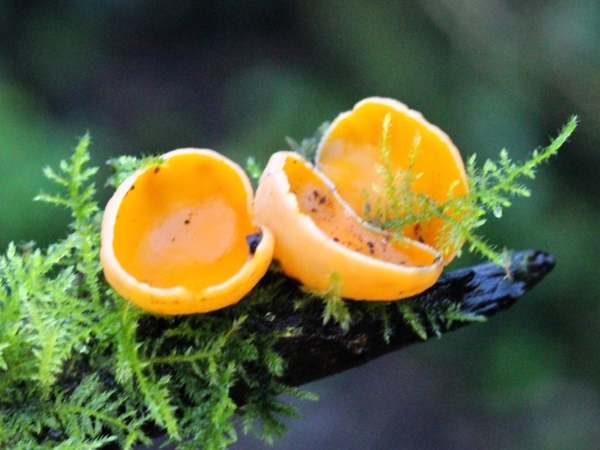
Synonyms of Sarcoscypha austriaca include Peziza austriaca Beck.
Etymology
The specific epithet austriaca means 'from Austria' and was chosen by the Austrian mycologist (Beck - see above) who first described this species scientifically.
Identification guide
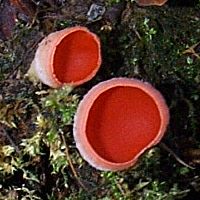 |
Description
The irregularly shaped cups have a smooth,
bright red hymenial (fertile) inner surface and a felted outer surface. Cup diameter ranges from 2 to 7cm when fully expanded; height typically 1 to 2cm. The outer (infertile) surface is paler than the inside, sometimes pinkish but often with an ochre tinge. It is covered in tiny hairs, which in this species are in the form of tangled coils. The curly nature of these hairs is a crucial identifying characteristic, but to see it clearly requires strong magnification. The
edges of young cups are often slightly incurved.
There is a short stipe or stem, up to 3.5cm long and 0.3-0.7cm wide, often buried in moss or leaf litter. The stipe is
the same colour as the outer surface of the cup or somewhat paler. |
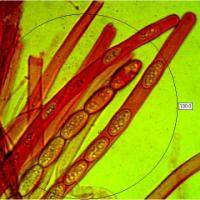 |
Asci
Cylindrical, typically 340 x 14µm.
Paraphyses
Paraphyses are sterile filamentous hyphae embedded within the hymenium. In Sarcoscypha austriaca they are filiform (very thin or needle-like), with a red or orange-red content.
|
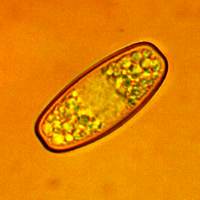 |
Spores
Ellipsoidal, 24-32 x 12-14μm; sometimes budding secondary conidial (asexual) spores from flattened or double-humped ends of mature ascospores. There are usually many small (generally 1 to 3μm in diameter) oil droplets distributed randomly in immature spores but often becoming concentrated towards the ends of the spores once they become fully mature.
Spore print
White. |
Odour/taste |
Not distinctive. |
Habitat & Ecological role |
On fallen hardwood twigs and
branches - most often those that are partly buried in moss. |
Season |
From spring through to the end of winter, but most
abundant in the colder months. |
Similar species |
Sarcoscypha-coccinea, the Ruby Elfcup, is virtually indistinguishable via macroscopic characters; it has straightish (uncoiled) hairs on the outer (infertile) surface of the cup and narrower spores that do not produce conidial buds (asexual spores).
Aleuria aurantia, the
Orange Peel Fungus, is larger, orange rather than red, and grows on
soil rather than on wood. |
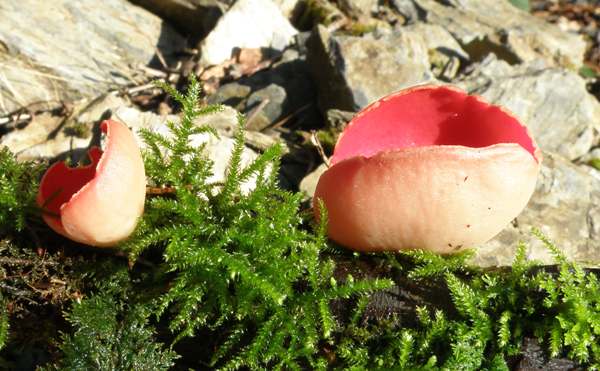
Culinary Notes
The Scarlet Elfcup and its close relative the Ruby Elfcup are considered by some authorities edible as long as they are thoroughly cooked. (Lacking in flavour, their main culinary value must be in the splash of colour that they could add to a mushroom dish.) A few field guides now record these fungi as inedible, and some even suggest that they are 'suspect'; therefore we advise against gathering Ruby Elfcups and Scarlet Elfcups for eating.
Reference Sources
Fascinated by Fungi, 2nd Edition, Pat O'Reilly 2016, reprinted by Coch-y-bonddu Books in 2022.
BMS List of English Names for Fungi
Harrington F A. (1998). 'Relationships among Sarcoscypha species: evidence from molecular and morphological characters'. Mycologia 90 (2): 235–43.
Ruini, S., Ruedl, E. (1998). Un nuovo taxon di Sarcoscypha. S. austriaca var. lutea var. nov. Rivista di Micologia 4: 319-324.
Dennis, R.W.G. (1981). British Ascomycetes; Lubrecht & Cramer; ISBN: 3768205525.
Breitenbach, J. & Kränzlin, F. (1984). Fungi of Switzerland. Volume 1: Ascomycetes. Verlag Mykologia: Luzern, Switzerland.
Medardi, G. (2006). Ascomiceti d'Italia. Centro Studi Micologici: Trento.
Dictionary of the Fungi; Paul M. Kirk, Paul F. Cannon, David W. Minter and J. A. Stalpers; CABI, 2008
Taxonomic history and synonym information on these pages is drawn from many sources but in particular from the British Mycological Society's GB Checklist of Fungi.
Acknowledgements
This page includes pictures of the orange and white forms of Sarcoscypha austriaca kindly contributed by Iris Millar and Donna Rainey.
Top of page...
Fascinated by Fungi. Back by popular demand, Pat O'Reilly's best-selling 450-page hardback book is available now. The latest second edition was republished with a sparkling new cover design in September 2022 by Coch-y-Bonddu Books. Full details and copies are available from the publisher's online bookshop...